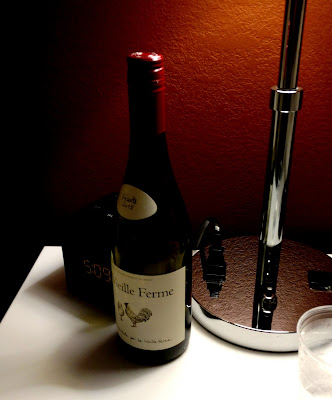 |
| Partly finished palm tree by Carol L. Douglas |
We rented our Bahamian cottage from a fellow artist from Spruce Head, Maine—Cali Veilleux. She’s a warm soul and has been very generous in sharing her time and knowledge. “I love seeing artists here,” she told us. (If you’re in the market for a Bahama rental, by the way, her place is comfortable and immaculate.)
When we first arrived, she gave us a tour. “That’s the best KFC in the world,” she announced. We all laughed because, of course, that’s setting the bar very low. We tried it last night. By gum, she was right. It was light, crunchy, and delicious; in short, not just your Colonel’s chicken.
The ice-cream colors of the cottages in our little neighborhood are lovely. We painted here in the morning while waiting for the weather to settle. I made it most of the way through my study of this palm tree and its shadow before it was time to head out to the beach.
| Another one that got away. I hope to get back there today. |
Alas, it was much too windy to paint on the shore, so we settled for a beachside lunch of grilled shrimp instead. When the wind refused to settle, we scouted inland.
There aren’t natural harbors on Grand Bahama Island, so people moor their boats in a network of canals and lagoons. For boat people like Bobbi Heath and me, that’s unfortunate, since they don’t show to best advantage. Nevertheless, we were invited by the Sir Charles Hayward Yacht Club to return to watch their under-10s do their sailing class later in the afternoon.
| Kitchen at Garden of the Groves, by Carol L. Douglas |
In the meantime, we went to the Garden of the Groves to paint foliage. This is a large artificial environment stuffed to the gills with birds and trees. It’s a sort of tropical Garden at Giverny, with innumerable painting moments. I, naturally, gravitated to the bar. This leaned over a small lagoon. I was wrapping it up when I heard a voice drifting over the water.
“We don’t drink and drive. We drink and then drive!” Oh, boy.
 |
| There were turtles everywhere in the Garden of the Groves. One kept me company while painting. |
The Optimist Pram class was everything you could hope for from a group of wee rascals. They were very good and managed to line up and race twice in the hour of their lesson. Nobody capsized, deliberately or otherwise. When they were done, several children came over to talk to us about our work.
| Optimist Pram Class at Sir Charles Hayward Yacht Club, by Carol L. Douglas |
“Do you know how old I am?” a boy demanded of Bobbi. “I’m six.” A moment later, he added, “I just peed my pants.”
We made it home with barely enough time to shower and dress for an opening for the Grand Bahamas Artists Association, which included work by Eva Dehmel and Cali. A mere two days on the island and we were invited to swill plonk with the natives.
| Grand Bahamas Artists Association opening. |
As the designated driver, I stuck to ice water. Even so, I was nearly killed walking across the street to the opening. The car in my lane stopped to let me through. The oncoming car never even slowed down, despite my wearing white and being in a lighted crosswalk. Bobbi and Joelle Feldman screamed a warning. I jumped back just in time. I wonder how drunk that fellow was.
“I would have hated to have to call Doug and tell him you were dead,” Bobbi told me after the shock had worn off. It’s nice to be loved.








